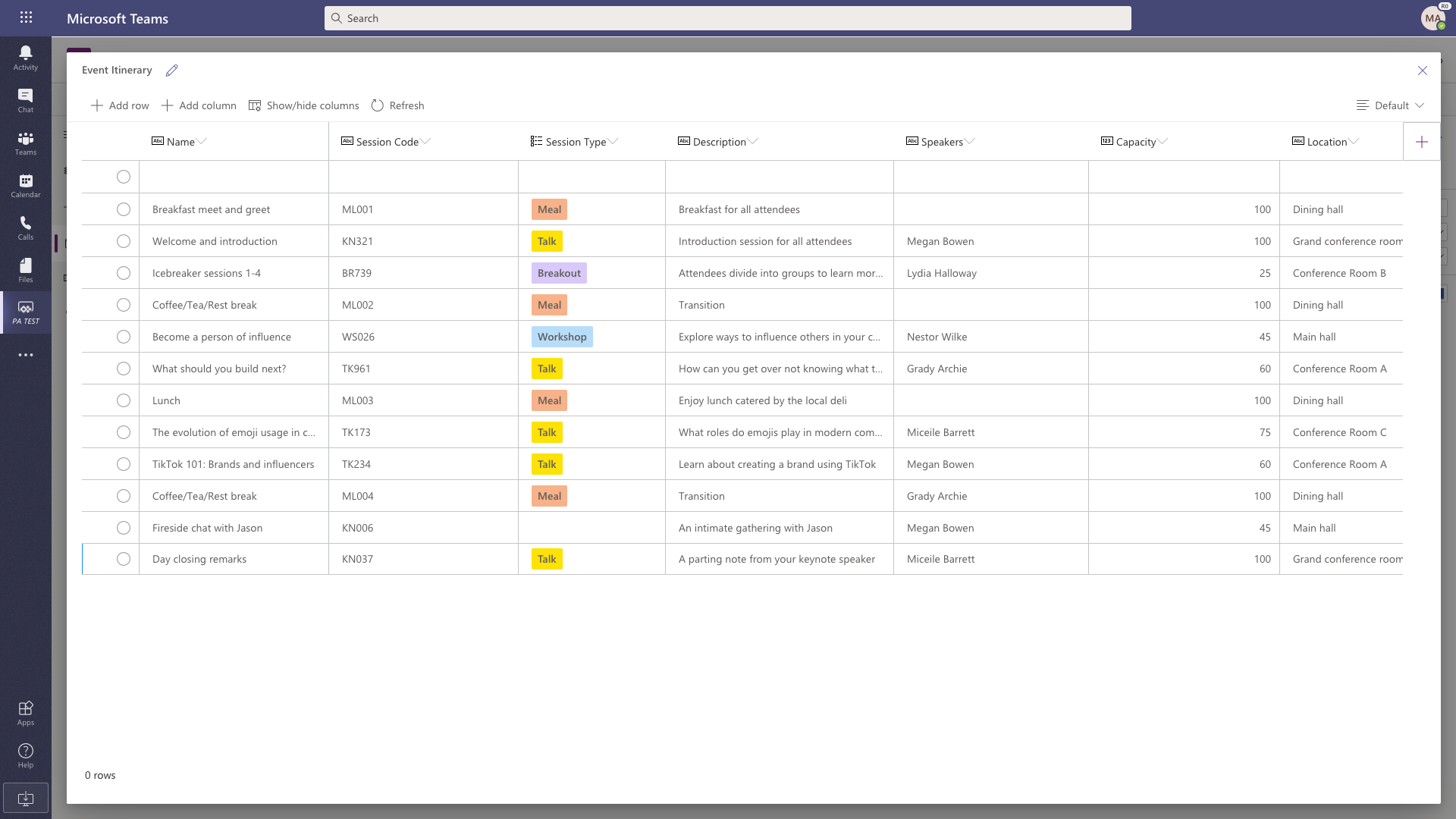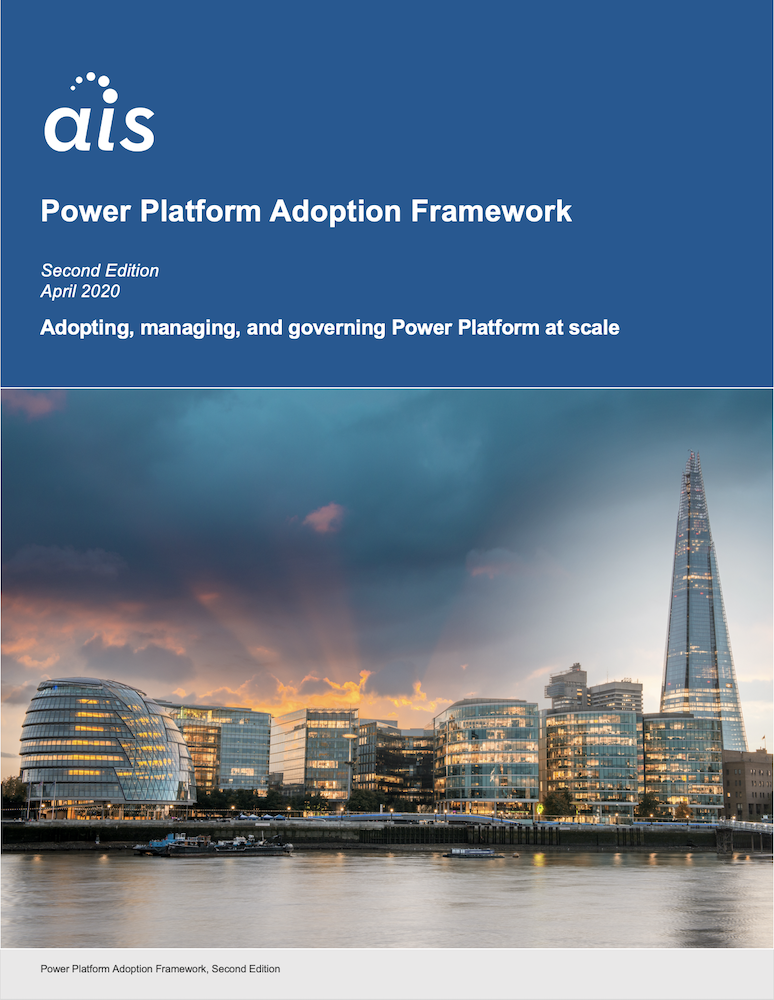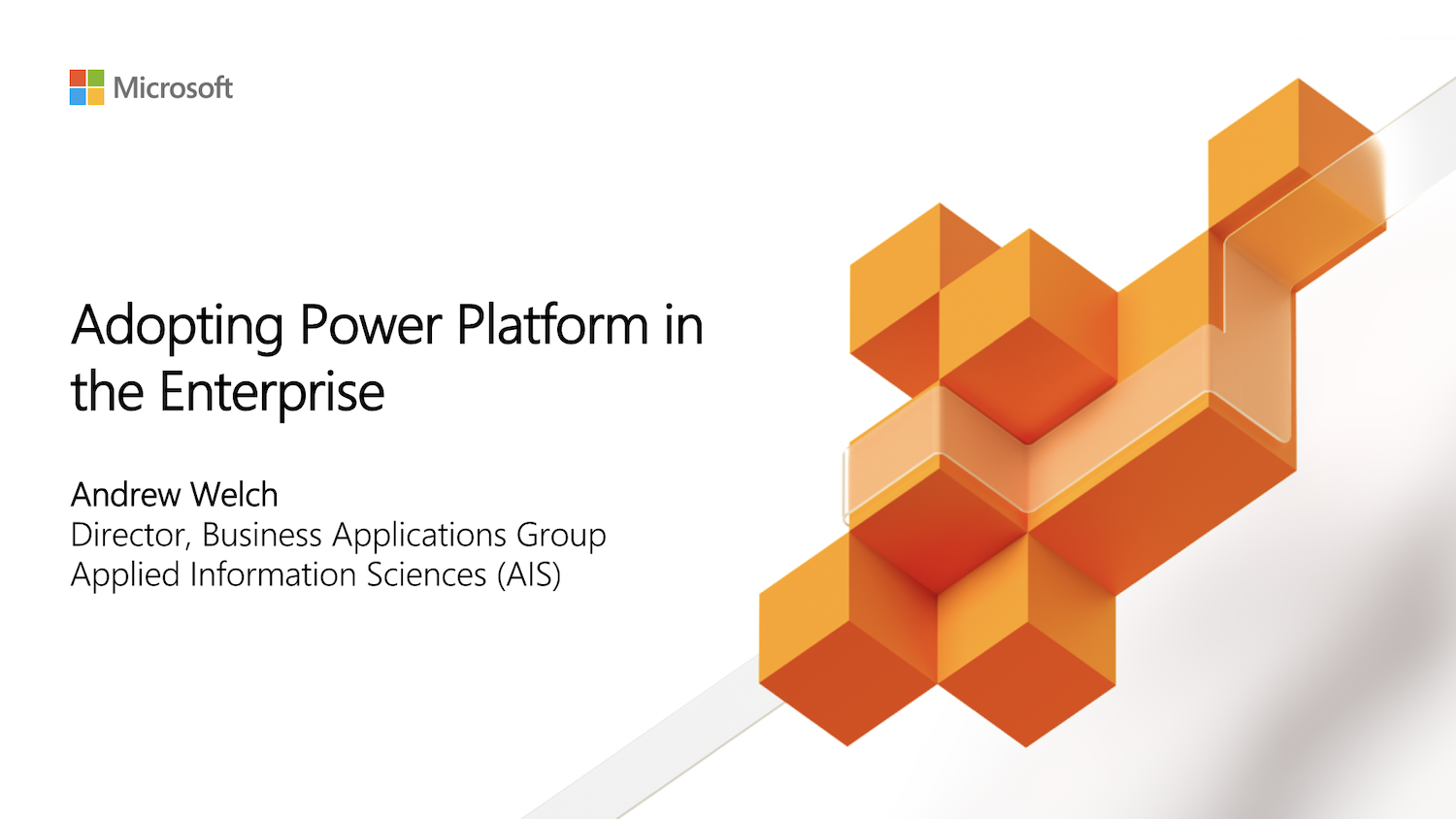Reflecting on Microsoft Ignite 2020: Five big strategic takeaways for Business Applications
This is the year that low-code cloud transformation goes mainstream. With that I’ll also share my top five reflections on Ignite from a cloud strategy perspective. Joe Griffin has got a great top five at a more detailed feature-by-feature level on his CRM Chap blog, and I also recommend you give a listen to Lisa Crosby’s and Megan Walker’s “Microsoft Ignite Session Recommendations“ on The Up Podcast (which, incidentally, needs to be part of your regular listening).

Seeking your contributions to what’s next for the Power Platform Adoption Framework
Lee Baker, Lucy Bourne, Manuela Pichler, Keith Whatling, and I recently put together seven major themes that we plan to address in the framework over the next six(ish) months. We’d like to share them with the community and ask for your contributions. Each of the themes listed below direct links to their milestone page on GitHub, where you can contribute your ideas, thoughts, approaches, etc. by creating new “issues”. You can also join us in open discussion of all our open issues at this link.

Four things to know and five things to do following the big Microsoft Dataflex + Teams announcement
Today’s public announcement of new Microsoft Dataflex and the re-branding of the former “Common Data Service” (CDS) as Microsoft Dataflex Pro is one of—if not the—most profound Microsoft product evolutions of 2020. There will be significant discussion and work on this in the weeks and months ahead, but for now I’d like to help folks contextualize this new development by asking two questions: What should I be thinking big picture with the launch of Microsoft Dataflex, and what should I do next to make sure my organization is ready?

A love letter to my team, Microsoft Partner of the Year for Power Apps and Power Automate
I am beyond excited to share that Applied Information Sciences (AIS) has been recognized as the Microsoft worldwide Partner of the Year for Power Apps and Power Automate. Permit me a brief love letter to my team… Emily Cartner is our solution architect who led the team behind a lot of what made this award possible. The rest of the group, too: Whether in India, Europe, or the United States, this business applications team is the world’s best. I am so grateful that these brilliant people (current and future) all choose to direct their talent and passion in the direction of our—and our clients’—collective success.

America was supposed to be about content of character, not birthright
I was heartened by 4th of July well wishes from two of my fellow Americans. One is Russian. The other is Irish. Both are now also American—yes, both are celebrating their first Independence Day as American citizens. I was grateful for their reminders of hope in dark times. They’ve also inspired me to share nearly the entirety of Chapter Five of Field Blends (below) in which the core group of characters find themselves out in Virginia’s wine country debating the essence of what it means to be American 🇺🇸

We are living through generations’ failure to have created something better. Now America burns as the world weeps, and it is for us to put out the flames.
My generation, the “end of history” kids, came of age at the dawn of the era of the things which might have been. And all their trials and terrors and ghastly wonders. All the things which our ancestors might have wrought but would never have lived to see. And we live among it now, and it is us, and we are that which they made in their own eras of wonton foolery.

On “being local”, the terroir that—like food and wine—imparts unique character to us all
Field Blends is a story that both revels in localness—everything occurs in real-world places—and wrestles with the idea of home. These are such important questions, and they form part of why I used wine as a metaphor throughout the story. For wine—and all the rest we eat and drink—like people, is fundamentally rooted in place. Though often exported and passed around the globe, wine is a reflection of the terrain in which its grapes grew, the climate that surrounded it and the hands that tended it when it was young.

Sharing the Power Platform Adoption Framework's second edition
Today we’re releasing the second edition of the Power Platform Adoption Framework. We're introducing some new ideas—and new ways of thinking about existing concepts—as we enter the Power Platform Adoption Framework's second year. As a "framework", we're committed to broadly applicable best practices for adoption at scale, not to being a technical manual.

Bespoke Badger is quarantine at its best: Ten tips for making your virtual pub a great success
The Bespoke Badger is next level. It is quarantine—and the world—at its best because it brings people together over drinks, laughter, and serious talk in a way that I would have never imagined virtually possible six weeks ago. These are my observations as to how others can build similarly special virtual spaces with friends, family, colleagues, and strangers. The secret here is in creating virtually the same sense of community that we’ve long created in the physical world.

Power Platform is a First Class Citizen in the Cloud Transformation + App Modernization journey
That’s what low-code cloud transformation and app modernization is really about: Harnessing the “65% Opportunity” with Power Platform as a first-class citizen for business applications amongst Microsoft’s “Three Clouds”. So what's driving this? And — perhaps more importantly — how do we do this at scale? How do we migrate one, two, or ten thousand workloads to Power Platform?

Millennials began turning 40 this year (and why that matters)
That the oldest are now turning forty is important not just because it must auger the end of an era when Millennial was a byword for the young, but also because it must auger the beginning of an era when this generation’s leadership in the world is a thing of the present. That era is here and now, not some distant time in the future.

Best Practice: Don’t be scared, embrace the Community!
The Microsoft Business Applications “Community” is a truly globe-spanning group of brilliant, capable, curious people who care deeply, meaningfully, and personally about not just the technology and its transformative potential, but about each other and about the world.
How I stay on track, focus on what's important, and get things done
The end of the year gives me cause to contemplate — as I do every year — that which I hope the coming year holds. I learned a long time ago, though, that a great many good things require purposefulness in order to really get done. Good work doesn’t happen accidentally. Trips don’t plan themselves. Family and friends from other places don’t always just stumble into your daily life. We each must be purposeful about making happen the things that we most value. It may seem cumbersome, but I find that a bit of deliberate thought up front helps keep me focused and centered throughout the year, quarter, month, week, and day.

Adopting the Microsoft Power Platform in the enterprise
This session introduces the Power Platform Adoption Framework and gives an overview of its start-to-finish approach to help you and your organization get the most value out of any form of Power Platform available to you today. We also share how other enterprise organizations have scaled with large and complex needs using Power Platform and what were the tools, best practices and patterns they explored and used to become successful adopters.

My new book — “Field Blends” — to be published spring 2020
Field Blends is a story of the world as it is today, consideration to the intersection of modernity, technology, culture, and the people, pasts, and communities that give each of us roots. It is told through the eyes of friends — wine in hand — in the tumult of love and self doubt, against the backdrop of our ever-changing world. It seeks reconciliation of life amongst the monuments, hideaways, and progressive thought of great European and American cities with the legacy of hometowns, mother countries, and family. I have written it to be joyful of the world’s beauty and melancholy of its present failures.

Power Platform Adoption Framework is now open for community collaboration on Github. Join us!
Last week at the PowerApps + Flow User Group in London, I shared the news that ongoing development of the Power Platform Adoption Framework is now happening on Github. Developers everywhere use Github to create software, and now we’re going to use Github to further build the framework that enables people to create beautiful and useful things on Power Platform deployed in large, enterprise-grade organizations.

Explaining Power Platform: How do the pieces fit together?
We can't truly embrace what we don't understand. Having a common understanding is critical to determine common best practices for adoption and beyond. The Microsoft Power Platform is a vastly capable technology, but many still struggle to put all of its pieces together in their mind. We'll take a moment to change that here.
It’s time for a shared, community commitment to Best Practices adopting and developing Power Platform
Now that we have what I will call a mature and evolving platform, it’s time that the community around that platform get serious about meaningful best practices. We owe it to our customers, our employers, and one another to adhere to a shared commitment to excellence and a body of best practices that back up the way we adopt the platform and develop solutions there.
We need to be thinking Power BI when we think Power Platform Adoption Framework
We need to use Power Platform Adoption Framework as an opportunity to embrace the whole platform, which means thinking about all the component parts — Power BI, Flow, PowerApps (and Common Data Service!) — when we think about enterprise adoption.

Introducing Power Platform Adoption Framework, the start-to-finish approach to adopting Power Platform at scale
I am so excited to be sharing the first edition of the Power Platform Adoption Framework, the start-to-finish approach for adopting Microsoft’s Power Platform at scale. The white paper is available at this link. My hope is that the framework will continue to become a worldwide standard for enterprise-grade adoption of the Power Platform.

